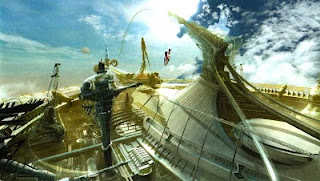For those of you who don't know, there are two major kinds of RPG's. The regular RPG aka ones made in the Western World like America and the JRPG aka the RPG from Japan. If you've been following gaming news or critics lately you'll hear about how people are expressing their disinterest to downright hate of JRPG's like the Final Fantasy series and Dragon Quest series.
So how are both so different? Let's take a look.
1. Graphics
-Most typical WRPG’s are dark and gritty looking graphics to set the mode of a mysterious environment. Games like Mass Effect, Dragon Age, Deux Ex, and Fallout all have an atmosphere that is similar to each other. Iin fact, future post apocalyptic themes are very popular in the western world because we see this theme so often and thus it becomes more familiar to us.
-In Japan, the graphics and art are very different. Things are colorful and full of life in the JRPG world and each art structure is unique to the core, meaning something different each time. A lot of JRPG’s are anime like and sometimes they have cartoonish looks. This is popular in Japan because their most popular media is anime, a cartoon like show that ranges from various audiences.
2. Battle System
-All RPG’s need a battle system with numbers, stats, and other familiar rules that RPG’s all follow. This is another major difference between the two. In the common WRPG, combat is Real Time meaning that the player controls the character in battle and can freely move around while commanding his allies or letting the AI take over. In this style of gameplay the player can perform actions at an instant, but that also means the enemy can too and it becomes a challenge for the player to think quick and take action just as quick to win the battle.
-In a JRPG, the most common form of combat is the Turn Based System. This is when the player can plan out his moves in a “Stand By Phase” while commanding his units to do specific actions. When the “Action Phase” is activate, all the commands the player and his allies perform are done as well as the commands of the enemy. Until the player is done with his “Stand By Phase”, the actual actions will not be performed. This is a good system for the long term strategic planer instead of the quick action guy like in the Real Time System. It’s more of a matter of two choices: do you like getting into the action and feeling the adrenaline rush of battle or do you like planning your moves carefully and strategically? JRPG’s also use a Grinding level up system where players must battle opponents in order to level up by searching for them rather than having them come to the player like in western RPG’s.
-This is one of the bigger issues that separate the two. In most WRPG’s, the story is not as focused as the gameplay, but the unique thing about these games is that their very open in terms of narrative. A very popular technique is what I call the “Open Narrative Choice System”. Take a game like Knights of the Old Republic. You can choose various responses and change the game’s story, as well as your party, depending on your choices. In the climatic choice in KOTOR, Bastila asks you to join the dark side. If you say yes, nearly all your party members will fight or abandon you and when you win you’ll join the dark side and create a new Sith empire. Declining her does the opposite.
-What most people assume about JRPG’s is that they focus more on linear storyline and gameplay. This is not always true. JRPG’s do follow a very linear storyline, but some games allow the player to still change the aspects of the ending or the story like the Shin Megami Tensei series. In that game you still need to go through a very linear storyline, but the choices you make can determine your ending. But to a Narrative guy like me, JRPG’s are like our bibles. The stories they create are amazing and the writing talent is just godlike.
Although there are many more examples while these two are different, these three are some of the main ones and the most common reasons. To me however, an RPG is and RPG and it doesn’t matter where it’s from as long as it has:
1. A good story
2. Interesting combat system
3. Creative environments and artwork
4. Interesting themes
5. Lasts longer than 30 hours and has repetitive gameplay
If it has any of this, then the RPG is a hit regardless of what type it is. Try playing a popular game from both side and see which one you like better.
Later







No comments:
Post a Comment